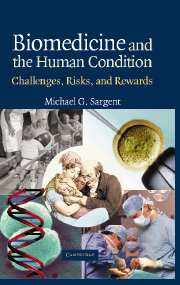Book contents
- Frontmatter
- Contents
- Preface
- 1 Challenges, Risks, and Rewards: Learning to Control Our Biological Fate
- 2 Learning to Breed Successfully
- 3 How Life is Handed On
- 4 Cells in Sickness and Health
- 5 Experiences in Utero Affect Later Life
- 6 Infection, Nutrition, and Poisons: Avoiding an Unhealthy Life
- 7 Signs of Ageing: When Renovation Slows
- 8 Cancer and the Body Plan: A Darwinian Struggle
- 9 Fighting Infection
- 10 Are Devastating Epidemics Still Possible?
- 11 Discovering Medicines: Infinite Variety through Chemistry
- 12 Protein Medicines from Gene Technology
- 13 Refurbishing the Body
- 14 Living with the Genetic Legacy
- 15 Epilogue: Signposts to “Wonderland”
- References
- Index
7 - Signs of Ageing: When Renovation Slows
Published online by Cambridge University Press: 06 August 2009
- Frontmatter
- Contents
- Preface
- 1 Challenges, Risks, and Rewards: Learning to Control Our Biological Fate
- 2 Learning to Breed Successfully
- 3 How Life is Handed On
- 4 Cells in Sickness and Health
- 5 Experiences in Utero Affect Later Life
- 6 Infection, Nutrition, and Poisons: Avoiding an Unhealthy Life
- 7 Signs of Ageing: When Renovation Slows
- 8 Cancer and the Body Plan: A Darwinian Struggle
- 9 Fighting Infection
- 10 Are Devastating Epidemics Still Possible?
- 11 Discovering Medicines: Infinite Variety through Chemistry
- 12 Protein Medicines from Gene Technology
- 13 Refurbishing the Body
- 14 Living with the Genetic Legacy
- 15 Epilogue: Signposts to “Wonderland”
- References
- Index
Summary
In an era when premature death is relatively rare, people eventually show the well-known signs of ageing and are afflicted by one or more diseases of old age. How we fare depends on our genes and our life experience, but even if our genetic constitution promises long life we may be robbed of it by the strenuousness of our lifestyle or by misfortune. The signs of ageing reflect inexorable chemical change to important proteins acquired in childhood that never renew, making some kind of decay in old age inevitable. A major culprit responsible for this chemical damage, and probably the major risk factor for age-associated disease, is oxidative stress caused by “free-radicals” that leak from our mitochondria and other subcellular particles. Reduced calorie intake, exercise, and adequate intake of antioxidant vitamins and essential fatty acids all militate against free radicals and arguably might slow physical ageing. Ageing at a cellular level seems to be governed by a molecular clock that limits the number of divisions a cell makes in a lifetime, which may have a role in reducing the danger from potentially malignant cells. This process, too, may respond to free-radical damage.
Life Span and Ageing
“We spend our lives as a tale that is told.” This notion of human existence, transient and predestined, is attributed to Moses and apparently dates from about 1500 b.c. (Psalm 90). He goes on to tell us that three-score years and ten are mankind's allotted lifespan.
- Type
- Chapter
- Information
- Biomedicine and the Human ConditionChallenges, Risks, and Rewards, pp. 132 - 152Publisher: Cambridge University PressPrint publication year: 2005



